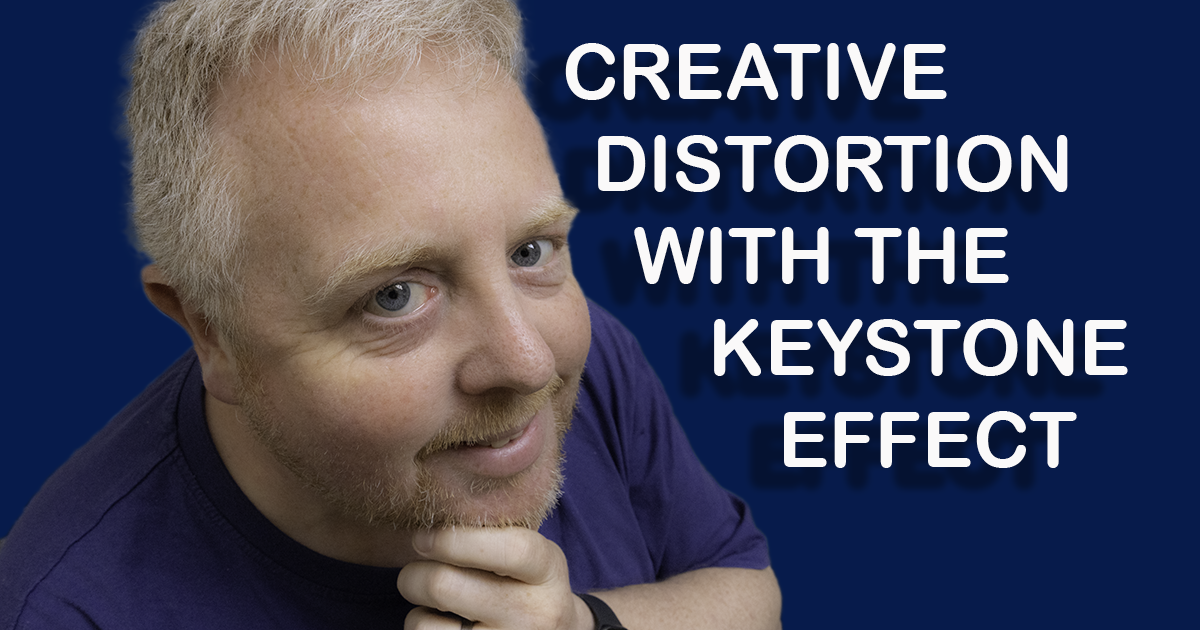May 4, 2022
Keystone distortion
The angle we point a camera can distort your photos. It’s called the keystone effect. Why does it happen, and how can we use it for effect?

If you take pictures of buildings, you may notice a strange effect, mainly if shooting on a wide-angle lens in a tall building. One of my first locations on my Switch to Manual workshop effectively demonstrates this effect. The windows on the Victoria Street shop in real life are vertical – the sides of the windows go straight up. The photo we take doesn’t show this, however. Instead, they lean inwards, almost as if they are falling toward us. This distortion is known as the keystone effect.

Why does keystone happen?
We stand on the pavement across the road to take the shot during the workshop. The windows are on the first floor of the row of shops opposite. To avoid getting any cars parked on the street in the shot, we point our cameras upwards by about 15 degrees. By doing this, the bottom of the camera is slightly closer to the windows than the top of the camera. As a result, the things at the bottom of the image will be captured on the sensor larger than those at the top.

The reverse is true if you shoot from above. This time the top of the camera is closer to the subject than the bottom. So, this time when the image lands on the sensor, the things at the top will appear larger than the things at the bottom.

How do we stop it from happening?
There are two ways that you can correct keystone distortion. The first is probably the most obvious but isn’t always possible. Either shooting from above or below creates both the issues above – positioning yourself so that the camera is exactly square to the subject. When we do this, the top and bottom of the subject are the same distance from the camera, so vertical edges will appear straight.

A few months ago, I covered the other way to fix keystone distortion. Using the Transform tool in Adobe Lightroom, we can make horizontal and vertical lines straight in a photo. This is the one we’d use for the Victoria Street photo, as it’s much easier than knocking on the door of the flat opposite to take the picture from their window!
Do we always want to correct keystone distortion?
You can imagine that an architectural photographer would usually want to photograph a building without keystone distortion. Estate agent photographers are encouraged to represent the building size accurately by shooting in a way that doesn’t distort the room size. In the two shots below, you can see that shooting from a high point downwards appears to make the room larger. That’s misrepresenting to the purchaser and is actively discouraged. However, there are times when you can use the effect to creative advantage.

By understanding the keystone effect, we can create distortions to use the enlargement of parts of the image to enhance the image. The first example below shows how we can accentuate the big toe of the David Hume statue in Edinburgh. Tourists rub the appendage of the philosopher for luck. By shooting upwards, we can feature this in the image while retaining it in the context of being part of something larger.

Similarly, I like to accentuate the size of foreground interest by pointing downwards at interesting rocks. What appears to be boulders at the front of the photo are, in reality, only about 30cms long. By getting close and pointing downwards, they give the impact of being huge against the Cuillin mountains in the distance.

I hope that this has inspired you to both avoid and use the keystone effect in your photography. It would be great to see some examples in the comments section below.
Please give us your feedback.
If you’ve got any questions or comments, leave them below. You can sign up for the Edinburgh Photography Workshop monthly newsletter, where you’ll get regular updates on exciting things happening in photography and some great tips. Sign up by clicking here.
About the author
 As well as running Edinburgh Photography Workshop, Rich Dyson is a professional photographer. His photographs are regularly used in newspapers such as The Times, Guardian and Daily Telegraph. He also had two solo exhibitions and was featured in a members sponsored exhibition in the Scottish Parliament. You can see and buy his photography at richdysonphotography.com.
As well as running Edinburgh Photography Workshop, Rich Dyson is a professional photographer. His photographs are regularly used in newspapers such as The Times, Guardian and Daily Telegraph. He also had two solo exhibitions and was featured in a members sponsored exhibition in the Scottish Parliament. You can see and buy his photography at richdysonphotography.com.